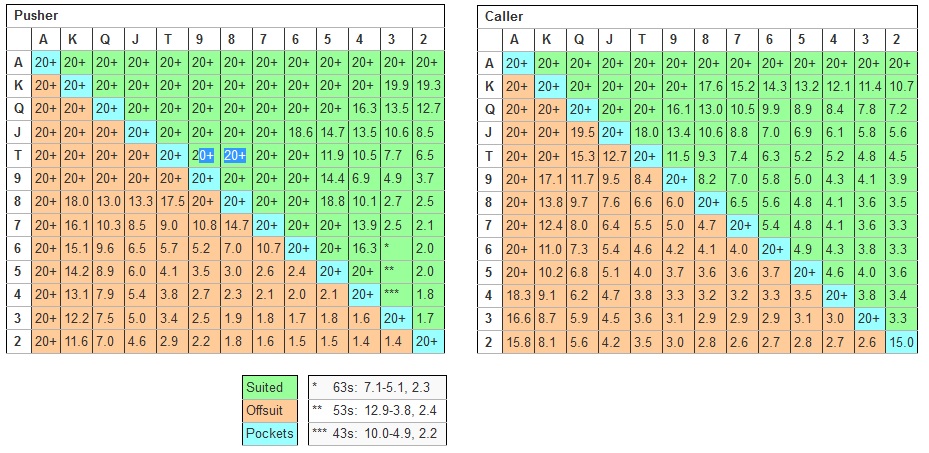Heads Up Poker Small Blind
The Small Blind is the smaller of two forced “bets” in Hold’em and Omaha. The Small Blind position is between the Button and the Big Blind. « View All Poker Terms Take the Most Popular Quiz on Upswing Poker! For any tournaments and cash games where players are Heads-Up, the small blind will be placed on the button. The button will then be first to act preflop and second to act in all further betting rounds. This rule is widely accepted and explained in the Robert's Rules of Poker, which the vast majority of poker rooms use these days.
Heads up poker requires us to play many hands. We need to be stealing the blinds more often from our opponent than in any other form of poker, and this means raising often from the small blind (Which is also the button in Heads-Up play).
Here's some pointers for opening from the button Heads-Up and why we should do it:
- Against an unknown opponent we should be opening 100% of the hands we have in position (on the button). We can double the blinds to achieve this or 2.25x when opening. We can keep it so small as we do it so frequently.

- On the button holding a hand like 103 seems like a fold, but we should open this hand heads-up. This is because our opponent in the Big Blind is juhst as likely to have a none-playable hand. From our opponents point of view, he'll be folding some hands which could be considered playable since he doesn't want to play often out of position. We can win another pot pre-flop simply by putting consistent pressure on our opponent when we're on the button.
- Always remember both players post blinds before seeing their hole cards. You're simply less likely to run in to a big hand heads-up. This is another reason we need to frequently steal our opponents big blind.
- We need to get value for our hands and stay balanced - This means opening AA in exactly the same fashion as we would with 72o. It's important to use the same bet-sizing pre-flop so that our opponent cannot read our hand.
- Never limp the button until we have to. Opening the same size constantly will make us the most money.
- We can adjust our button opening range if our opponent begins to play back and adjust to our strategy - But the default should always be 100% opening.
Heads-Up Rules for Texas Hold’em Poker
Heads up Texas Holdem is one of the most fun, challenging and misunderstood variations of holdem. The thrill of playing a friend or foe in a battle of heads up holdem is unmatched in all of poker. Is he bluffing? Does he have the nuts? Should I value bet my second pair? Well, I will not get ahead of myself just yet. Before you can play Texas Holdem heads up against an opponent, you have to know the rules, right?
Best Poker Sites for Heads-Up Texas Hold’em
| Logo | Visit Site | Rating | Bonus | Code | Poker Room Review |
|---|---|---|---|---|---|
| 888 Poker | 98% | €400 + €20 Free | n/a - use link | 888 Poker | |
| Party Poker | 96% | €350 | PPAL500 | Party Poker | |
| PokerStars | 89% | €600 | MIK500 | PokerStars |
Must be 18+ - Terms & conditions apply to all bonus offers
Heads Up Poker Dealer Small Blind
Texas Holdem Heads Up Rules – Button Position
Heads Up Poker Who Is The Small Blind
Without a doubt, the single heads-up rule that creates the most confusion is who has the button and who has which blinds?
The first thing that confuses people is that the rules are different if you are playing at certain online poker site or playing live poker. It doesn’t make any sense, but some online poker rooms started setting the blinds backwards from what was generally accepted in live heads-up poker games for decades. I am going to explain the heads up rules for live poker for the sake of simplicity. The following Heads-up Texas Holdem rules apply to both tournaments and cash games.
Proper Preflop Head-Up Blinds Setup:
Heads-up Button Position and Dealing:
- The button has the small blind when playing Texas Holdem heads up.
- The person who is the dealer has the button and also posts his/her small blind. This means that the other player (without the button) is the big blind.
- The small blind acts first on the first round of betting before the flop (pre-flop).
- The dealer (button) deals the small blind the first card, and the second card to the other player (big blind). Deal the 3rd (total) card to the small blind and the last card to the other player. This leaves each player with two hole cards and the first round of pre-flop betting can begin.

Heads-up Pre-flop Betting:


- The small blind can fold, call or raise.
- If the small blind just calls, then the big blind (non-button player) can either check and see the flop, or raise.
All Other Rounds:
- The flop is dealt (3 cards).
- The person who was big blind pre-flop is first to act on the flop. (In case you forgot, this is the player who does NOT have the button – the button acts last on all streets except pre-flop.)
- The player who is first to act can bet or check. If that player checks, the button can then bet or check.
- If both players check, then the dealer deals the turn.
- Repeat the betting sequence for the turn and the river. (the 5th card)
- After all rounds of betting are complete, both players show their hands and the person with the best hand wins!
Now wasn’t that fun?!? If you think you got the hang of Texas Holdem heads up rules or you would just like to practice for free or for real money, I would suggest downloading Full Tilt Poker. Full Tilt is the poker room I rate the highest for heads up play. There are at least one hundred Texas Holdem heads up tables available 24/7.